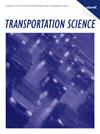有访问限制的车辆路由问题
IF 4.8
2区 工程技术
Q1 OPERATIONS RESEARCH & MANAGEMENT SCIENCE
引用次数: 0
摘要
为了减轻货运车辆对城市地区的负面影响,许多城市都实施了道路通行限制措施,包括在一天中的某些时段限制进入特定区域的限行区。即使在穿越时间和旅行成本相等的假设下,实施这些区域也需要在运送成本和时间之间做出权衡。因此,负责车辆路线规划的规划人员需要处理包含所有帕累托最优路径信息的图形。受城市物流中的这些变化以及由此带来的计算挑战的启发,我们研究了有通行限制的车辆路线问题,即在给定时间段内某些街道禁止通行。我们使用工作日变量来表述这个问题,并根据底层道路网络和多图提出了两种分支和价格算法。我们的计算实验结果证明了所提算法的有效性,解决了多达 100 个节点和 33 个客户的实例,并强调了考虑替代路径对降低成本的重要性:本研究由鲁汶大学[C14/22/026]资助。本文章由计算机程序翻译,如有差异,请以英文原文为准。
The Vehicle Routing Problem with Access Restrictions
To mitigate the negative effects of freight vehicles on urban areas, many cities have implemented road accessibility restrictions, including limited traffic zones, which restrict access to specific areas during certain times of the day. Implementing these zones creates a tradeoff between the delivery cost and time, even under the assumption of equal traversal time and travel cost. Consequently, the planners in charge of vehicle routing need to work with graphs containing information on all Pareto-optimal paths. Inspired by these changes in city logistics and the resulting computational challenges, we study the vehicle routing problem with access restrictions, where some streets are closed to traffic within a given time period. We formulate this problem using workday variables and propose two branch and price algorithms based on the underlying road network and multigraph. The results of our computational experiments demonstrate the effectiveness of the proposed algorithms, solving instances with up to 100 nodes and 33 customers, and underline the importance of considering alternative paths in reducing costs.Funding: This work was supported by KU Leuven [C14/22/026].
求助全文
通过发布文献求助,成功后即可免费获取论文全文。
去求助
来源期刊

Transportation Science
工程技术-运筹学与管理科学
CiteScore
8.30
自引率
10.90%
发文量
111
审稿时长
12 months
期刊介绍:
Transportation Science, published quarterly by INFORMS, is the flagship journal of the Transportation Science and Logistics Society of INFORMS. As the foremost scientific journal in the cross-disciplinary operational research field of transportation analysis, Transportation Science publishes high-quality original contributions and surveys on phenomena associated with all modes of transportation, present and prospective, including mainly all levels of planning, design, economic, operational, and social aspects. Transportation Science focuses primarily on fundamental theories, coupled with observational and experimental studies of transportation and logistics phenomena and processes, mathematical models, advanced methodologies and novel applications in transportation and logistics systems analysis, planning and design. The journal covers a broad range of topics that include vehicular and human traffic flow theories, models and their application to traffic operations and management, strategic, tactical, and operational planning of transportation and logistics systems; performance analysis methods and system design and optimization; theories and analysis methods for network and spatial activity interaction, equilibrium and dynamics; economics of transportation system supply and evaluation; methodologies for analysis of transportation user behavior and the demand for transportation and logistics services.
Transportation Science is international in scope, with editors from nations around the globe. The editorial board reflects the diverse interdisciplinary interests of the transportation science and logistics community, with members that hold primary affiliations in engineering (civil, industrial, and aeronautical), physics, economics, applied mathematics, and business.
 求助内容:
求助内容: 应助结果提醒方式:
应助结果提醒方式:


